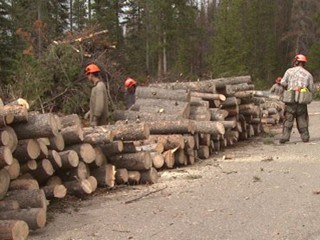Thanks to Matthew Koehler for this find.
UM Study Finds Logged Forests More Prone To Severe Wildfires
Oct. 04, 2010
UM Press Release: http://news.umt.edu/2010/10/100110fire.aspx
Copy of Ecological Applications article: http://rintintin.colorado.edu/~cana4848/papers/Naficy_et_al_2010_Ecol_App.pdf
Contact:
Anna Sala, professor, UM Division of Biological Sciences, 406-243-6009, [email protected] .
MISSOULA – Historically logged forest sites are denser and potentially more prone to severe wildfires and insect outbreaks than unlogged, fire-excluded forests and should be considered a high priority for fuel-reduction treatments, according to a new University of Montana study.
Anna Sala and Cameron Naficy, the lead researchers in the study, published an article on these findings in the most recent issue of the journal Ecological Applications. Sala is a professor in UM’s Division of Biological Sciences, and Naficy graduated with a master’s degree from UM in 2008.
Sala and Naficy’s study compared logged, fire-excluded sites to unlogged, fire-excluded sites in forests mainly consisting of ponderosa pines. The study covered a broad region spanning the Continental Divide of the Northern Rockies, from central Montana to central Idaho.
The findings contradict much of the conventional wisdom defining current U.S. forest policy, which assumes that increases in forest density, which in turn increase the susceptibility to severe wildfires or insect outbreaks, are primarily caused by fire suppression.
“This is an important finding because it highlights that vegetation management can result in long-lasting changes to forests that are likely to affect how large-scale disturbances, such as wildfires or insect outbreaks, play out on the landscape well into the future,” Naficy said.
“Furthermore, it shows that previously harvested and unharvested forests have very different restoration needs and fire hazard potential,” Sala said. “This recognition should go a long way in helping land managers to prioritize restoration and fuel-reduction efforts where they are most likely to be successful.”
For more information, call Sala at 406-243-6009, e-mail [email protected] or e-mail Naficy at [email protected] .
# # #
Naficy, Cameron, Anna Sala, Eric G. Keeling, Jon Graham, and Thomas H. DeLuca. 2010. Interactive effects of historical logging and fire exclusion on ponderosa pine forest structure in the northern Rockies. Ecological Applications 20:1851-1864. [doi:10.1890/09-0217.1]
Increased forest density resulting from decades of fire exclusion is often perceived as the leading cause of historically aberrant, severe, contemporary wildfires and insect outbreaks documented in some fire-prone forests of the western United States. Based on this notion, current U.S. forest policy directs managers to reduce stand density and restore historical conditions in fire-excluded forests to help minimize high-severity disturbances. Historical logging, however, has also caused widespread change in forest vegetation conditions, but its long-term effects on vegetation structure and composition have never been adequately quantified. We document that fire-excluded ponderosa pine forests of the northern Rocky Mountains logged prior to 1960 have much higher average stand density, greater homogeneity of stand structure, more standing dead trees and increased abundance of fire-intolerant trees than paired fire-excluded, unlogged counterparts. Notably, the magnitude of the interactive effect of fire exclusion and historical logging substantially exceeds the effects of fire exclusion alone. These differences suggest that historically logged sites are more prone to severe wildfires and insect outbreaks than unlogged, fire-excluded forests and should be considered a high priority for fuels reduction treatments. Furthermore, we propose that ponderosa pine forests with these distinct management histories likely require distinct restoration approaches. We also highlight potential long-term risks of mechanical stand manipulation in unlogged forests and emphasize the need for a long-term view of fuels management.











